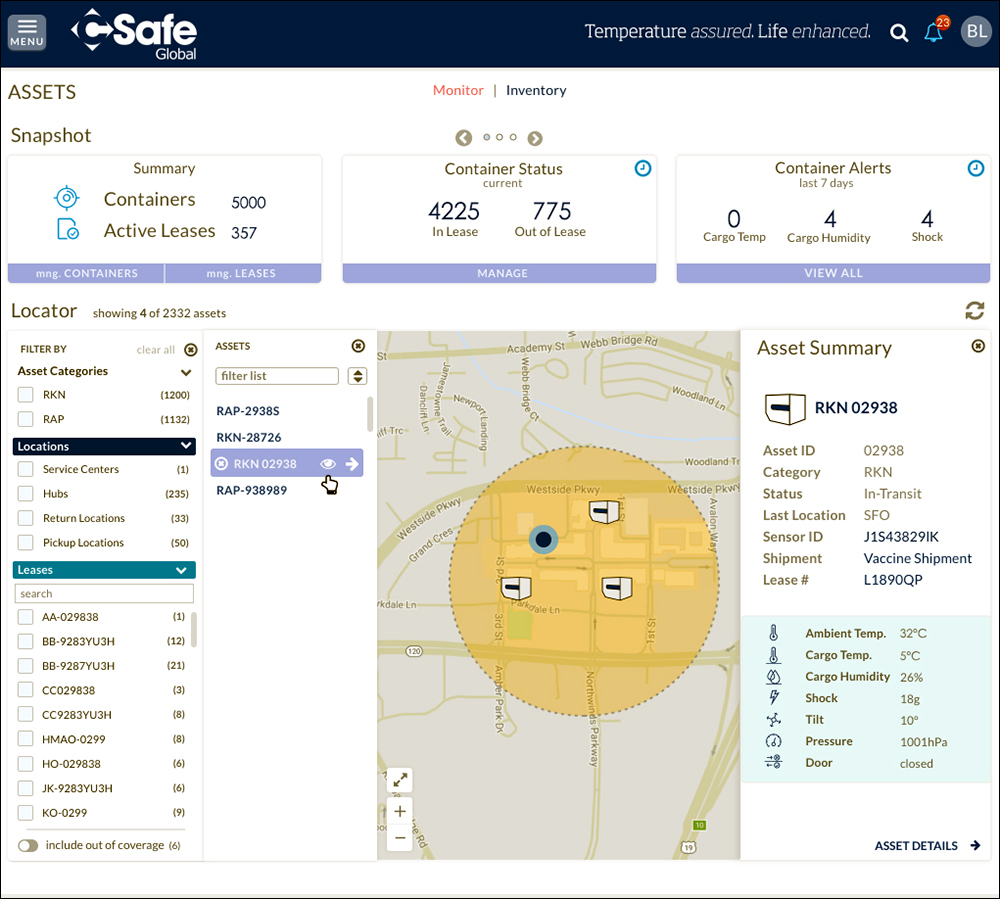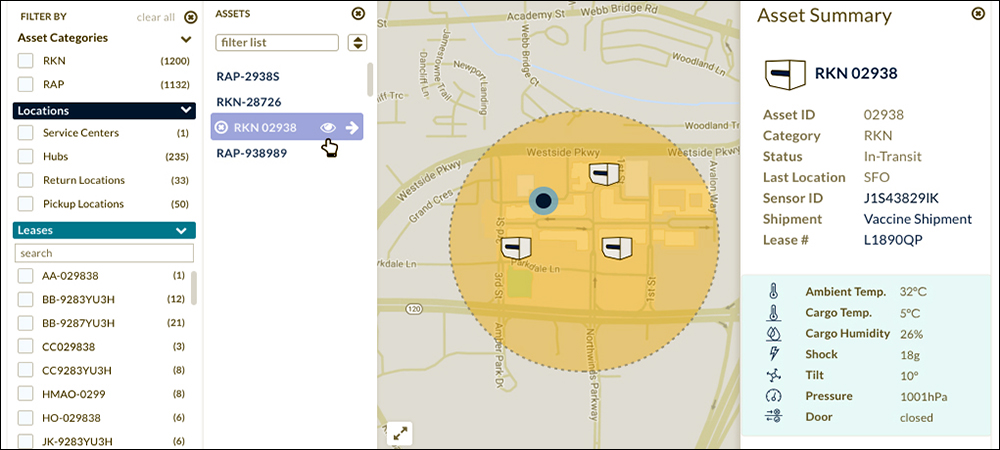CSafe Global provides thermal, temperature-controlled air cargo containers designed to deliver drugs and vaccines to global destinations within specific temperature ranges. Recently, the company has expanded beyond offering the containers to providing an Internet of Things (IoT)-based track-and-trace solution that helps users automatically capture and manage data regarding the conditions at which temperature-sensitive products travel around the world, as well as their location at any given time.
The cloud-based Digital Visibility Platform is provided through CSafe Global’s partnership with software solutions company Cloudleaf. The sensor-based track-and-trace system, currently being piloted by DHL and several pharmaceutical companies, is aimed at preventing the loss of vaccines or medications due to shipment excursions, such as rises in temperature. The collected data can be viewed and managed by CSafe and its customers.

CSafe provides a large percentage of the fewer than 10,000 active air cargo containers in the industry, which are used to move vaccines and other life-sciences products around the world in controlled conditions. Its customers include airlines, freight forwarders and life-sciences companies. The containers are leased by the shipper or manufacturer, and the solution is designed to provide those companies, as well as their customers in some cases, with information about the conditions to which the products were exposed.
CSafe’s active air cargo containers have always recorded ambient and payload (internal) conditions, but the data was only available after the shipment was completed. With a new cloud-based platform, the container information, including GPS location, container tilt and shock, can be viewed in real time, according to Tom Weir, the firm’s COO.
Cloudleaf is a five-year-old Silicon Valley company. CSafe chose its customized Digital Visibility Platform to support its existing track-and-trace solution and to provide a real-time view of products traveling through the cold chain. CSafe began working with the technology company early this year. Granular visibility into product flow and condition, Weir says, is essential to CSafe’s 185 pharmaceutical customers that rely on its cold chain solutions to monitor and protect high-value vaccine and drug transports, “in adherence with regulatory and safety standards.”
One of the primary reasons CSafe chose Cloudleaf’s cloud-based solution, Weir explains, is that the software can be integrated with its existing software, as well as that of its customers. Because the platform is device-agnostic, CSafe can leverage its own sensors and data without having to replace any foundational infrastructure. As a result, he says, CSafe this year integrated 20 containers with active, battery-powered sensors, which transmit information to the Cloudleaf platform. The company is now conducting pilots.
Cloudleaf offers its Digital Visibility Platform for shipping solutions, says Mahesh Veerina, the company’s CEO. Cloudleaf’s core focus is on continuous visibility and intelligence, he says, adding, “Visibility is the foundation to build other solutions upon.” The company offers a horizontal platform that could be leveraged across multiple industries, “but we chose our core focus on the pharma and life-science cold chain.” According to Veerna, the technology also targets the food and beverage and high-value manufacturing sectors, in which condition monitoring is key.
CSafe has thousands of active containers supporting the life-sciences market. The company shares supply chain data by manually collecting information post-shipment at transaction points and via its service network, where containers are handed off or received, or are maintained and inspected. One challenge it faces is monitoring temperature levels and other conditions. If an operator forgets to shut the container door after loading a product, for instance, and if the temperature falls outside acceptable parameters, detecting when that happened and responding quickly can be difficult. Instead, the company wanted to be able to proactively intercept and protect products, and to see such problems before they happen.
The company offers two types of containers: the RKN, measuring 48 inches by 50 inches by 50 inches, and the recently released RAP model, designed for bulk shipments of vaccines and measuring 125 inches by 88 inches by 64 inches. These are highly complex containers, Veerina says. Proper management requires a variety of sensors to detect not only internal temperatures but also humidity, whether the hatch is open or closed, ambient temperatures and battery levels.
Each container includes a shock sensor and other sensors to detect tilt and barometric pressure. The data is collected on a single sensor unit that comes with GPS location data and forwards the information via a cellular connection. The unit can be set to forward data every 10 or 15 minutes, or at any other frequency. If no cellular connection is available, the system will store each sensor measurement. In that way, if a container is in the air, for instance, the data can be collected once the airplane lands.
For a typical transaction, a customer would first log into CSafe’s site with a lease request, indicating where the container will be going, as well as when. The user can also indicate what product is being shipped and its temperature requirements. The software will set up a geofence route based on transit planes, along with the temperature levels or other sensor excursions that would need to be detected, and how these excursions would be disseminated to authorized parties, such as by e-mail or text message. The company would then pick up the container at the airport and turn on the unit, and the data would be captured automatically until the container reached its destination.
“Alerts are configurable,” Weir states, “so a customer can decide where they want the alerts to go.” The company not only provides data for its customers but also uses the information for analytics internally, in order to improve its own operations. The most common cause of failure, for example, tends to be human error, such as an operator forgetting to turn a cooling unit on or off. By collecting data in real time, he says, “This allows us to react to those process challenges.”
CSafe uses the technology for its own asset management and logistics. “Getting our containers to the right place at the right time, and in the most cost-effective way possible,” is the goal, Weir says, as is sharing a value-add with customers. The technology allows CSafe or its customers to intervene in a temperature excursion and thereby prevent product loss in real time, he explains, adding, “We’re much more than a hardware company today. We’re hardware and software, and that’s very important for us. If you don’t have capability to leverage AI [artificial intelligence], you won’t be a player” in the future cold supply chain industry.
With vaccines now under development and in clinical trials to address the problem of COVID-19 transmission, CSafe and Cloudleaf say they are poised to be part of the solution in distributing vaccines to those who need them. “We’ve done everything possible to be a reliable, robust partner in that process,” Weir says. With regard to the future need to distribute vaccines, he adds, “Supply chain resiliency and visibility is the only way we’re going to be able to manage this huge challenge ahead of us.” The company will be ready to help support the movement of vaccines when the time come, he predicts.
The initial testing—which was carried out with 20 containers retrofitted with sensors, integrated into the Cloudleaf platform—has been successful, Weir reports. The technology has been tested with multiple shipments across three international lanes, and a commercial launch is expected in late October 2020. The company is now in the process of retrofitting all of its containers this summer. “We’ve proven we have the right technology in place,” Weir says.


